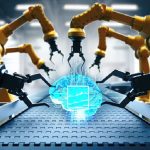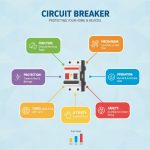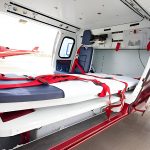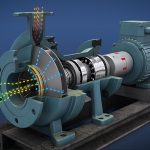In recent decades, there has been a drastic addition of medical robots into the healthcare system and has impacted almost all areas of medical management including surgery, diagnostics, and patient care. For the medical robots that are gradually developing over time, it not only increases the accuracy and efficiency of the medical operations, but also optimizes the benefits for patients and care perceptions.
Introduction to Medical Robots
Medical robots apply to all forms of robotics equipment used in the medical field for minimally invasive operations and diagnostic and patient care applications. These sophisticated devices are augmented with AI, machine learning, and leading-edge sensors to allow them to complete demanding functions with precision and repeatability.
Medical robotics as a field has received much consideration over recent past and some examples of medical robots include surgical robots, rehabilitation robots, telepresence robots, and diagnostic robots. As the of these technologies, a drastic change has struck the healthcare system and shifted the overall health care delivery in a positive way and is becoming very accessible.
Our comprehensive Medical Robots Market report ready with the latest trends, growth opportunities, and strategic analysis- View Sample Report PDF

Revolutionizing Surgery with Medical Robots
Minimally Invasive Surgery
Surgery remains one of the most commonplace for uses of medical robots in the field. Among the robotic surgeries, the most used is the da Vinci Surgical System because of its efficiency in the minimally invasive surgery. These surgeries require smaller incisions, and they cause lesser blood loss, less time to recover and have a low susceptibility to infector.
Medical robots can help surgeons perform complex operations with greater accuracy because they show surgeons 3D real-time images of the operation site. The robotic arms are operated by the surgeons with better sensitivity and the formation of tiny holes allows the insertion of instruments hence shorter normal incisions and scarring and healthier recovery of the patients.
For instance, in robotic prostate surgery of robotic cardiac surgery, robots allow surgeons to maneuver in a way that if done with hands is laborious. Robotic systems are most useful where there is a high risk of surgery, where accuracy is paramount, for example in brains, spine or ENT operations.
Remote Surgery and Telepresence
Another advanced area of structure in the field of robotic surgery is remote surgery or telepresence surgery. This makes it possible for surgeons to carry out operations from remote areas by intermediate teleoperated robotic systems. This is particularly advantageous given that effectively containing the occurrence of complications or negotiating the challenges posed by complex procedures is often a challenge in practice especially for rural or underprivileged populations who may rarely encounter access to skilled surgeons.
Remote surgery is facilitated by internet connection and video conferencing so that a surgeon can effectively manipulate the robotic arms and attend to any variations in the situation encountered by the operative team on the other end. These are helping reduce a geographic divide in medical services to reach out and bring specialized surgeries to even more people internationally.
Transforming Diagnostics with Medical Robots
AI-Powered Diagnostic Robots
In diagnostics, medical robots are using artificial intelligence in order to enhance the speed and efficiency of the diagnosing processes. Self-driven diagnostic devices can help in such diseases as cancer, heart diseases, neurological diseases among others by interpreting medical images, laboratories and patient information. These robots do not only help doctors in diagnosing diseases but also offer information that may well be very helpful to the naked eye.
For instance robotic systems with AI and machine learning technologies are being adopted in diagnostics and analysis of images like X-rays, MRI and CT scans. These robots are capable to diagnose the disease within shortest possible time like tumors, fracture or any pathological changes and results in efficient diagnostics.
In oncology, artificial intelligent diagnostic robots have also been found useful in determing early stages of cancer. These robots in particular use images to diagnose themselves for a tumorous growth at the embryonic stage thus allowing doctors to intervene and increase the chances of eradication. However, point-of-care diagnostic systems that employ artificial intelligence are also being incorporated and used for rapid detection at the patient care bed side.
Robotic Pathology
Another future trend of the robotic system in diagnostic medicine can be identified as robotic pathology. Cytotechnologists have long been applying conventional methods involving a microscope in performing histological examinations on tissue samples. In the pathology processes, these steps could normally take a lot of time but with the help of robotic assistance these can be designed and completed much in advance and with efficiency.
Robotic pathology systems are enabled to view sides, learn about abnormal cells, and produce diagnostic reports to be used by pathologists to diagnose diseases such as cancer. Such systems minimize human interference, offer a consistent and feasible approach to pathology departments.
Enhancing Patient Care with Medical Robots
Robotic Rehabilitation
Rehabilitation robots on the other hand are built for patients who undergo an operation or injury with difficulty in mobility. These robots offer patients mobility and physiotherapy and exercises needed to enhance recovery. Many of them have mobility monitoring built in, which allows the devices to monitor patient’s movements and adapt the therapy program to their achievements.
There is for instance the robotic exoskeleton used in rehabilitation of spinal cord injuries or neurological disorder to enable one to walk. These wearable robots help and aid the movements of the user sand thus help him practice walking and standing.
The case of the application of the robotic rehabilitation systems has benefited in enhancing the locomotion or the extent of improvement amongst the post-stroke, Traumatic brain injury or Orthopedic surgery patients. These robots in particular provide patients with the most effective rehabilitation plan which they require to attain so that they can recover as soon as possible.
Robotic Nursing Assistants
Another category of nursing assistances is also gradually being implemented in patient care most of which are assumed in healthcare institutions such as hospital and nursing homes. There are two categories of robots which assist the healthcare providers: delivery robots which dispense medication, capture vital signs and provide mobility assistance. It can assist human nurses and doctors to pay much of their time on critical patient’s issues as they enhance the general performance of healthcare facilities.
EXAMPLES: The Tug robot is employed in moving supplies, medication and clean linen within hospitals in the field hence relieving the care givers of the physical stress. Further, social robots are being built to add value /interact with patients and as a result enhance emotional health of the patients such as elderly patients.
Patient Monitoring and Telehealth
Robotic enabled telehealth platforms are redesigning the manner in which patient monitoring is carried out. Robots that are connected to telemetry can therefore monitor a patient’s symptoms, dispense drugs, and signal changes in the patient’s status.
Telemedicine robots allow interaction between patient and doctor/healthcare provider without having to make physical trips to the doctor’s office. This is particularly desirable in certain patients like chronic disease patients or patients in the rural regions. Through robotic systems to monitor and communicate round the clock, patients can be easily managed by early intervention, eradication of readmission and enhanced general health standards.
Overcoming Challenges and Future Prospects
However, there is still several issues that need to be resolved regarding the medical robots which have such great effectiveness. The initial investment is extremely high because of the mechanical components of robotic systems, and this is one of the key issues likely to discourage people from embracing robotic technology particularly in areas of poor resources. However, there are also problems with stability and safety of such systems and their feasibility in essential clinical procedures.
With progression in the kind of technology used in medical robots, their cost, availability and safety are likely to enhance. Artificial intelligence and machine learning will also keep on improving the functionality of medical robots, expand the specialty of the work that can be executed unswervingly. In addition, technology advancements coupled with inter-disciplinary integration of multidisciplinary processes which comprise of exercising programmers’ collaborative effort, as well as active collaboration between health care investors and researchers will foster development of newer uses of medical robots in patient support.
For Medical Robots Market Report and updates detailed: View Full Report Now!
Conclusion
Medical robots are reshaping the landscape of modern healthcare system with a new approach to handling diagnoses, surgeries, and care giving. These robots can drive the future of medicine as they bring greater precision over work, minimize human contact with virus and bacteria, and allow people to receive medical services remotely. By the realization of the above aspects, medical robots will continue to increase its significance in the development of the health sector by enhancing comprehensive and patient centered and efficient and accessible treatment.
The future development of medical robots is almost certain to diversify in areas such as life-saving operations and individual treatment methods. The future health wise is promising and it is oversees that medical robots are leading towards it.
See the whole Medical Robots Market study by Vantage Market Research for a thorough examination of market projections, major players, and geographical trends.
![[Market Research Reports] – Research Google News Blog | VMR.Biz](https://www.vmr.biz/wp-content/uploads/2022/12/logo-removebg-preview.png)











